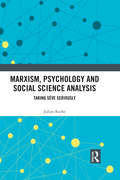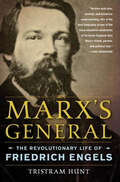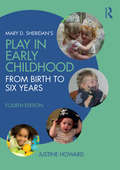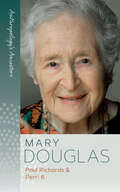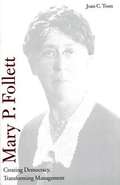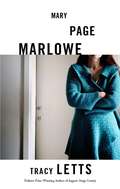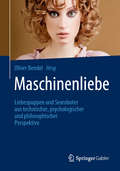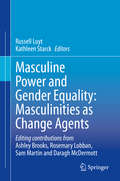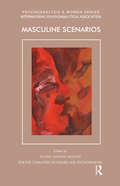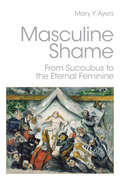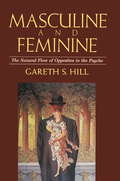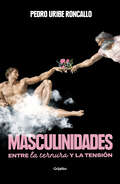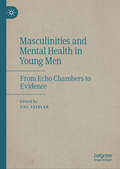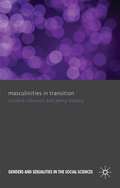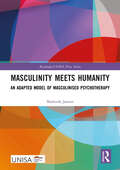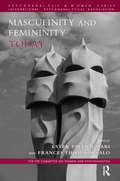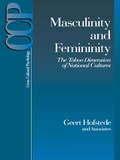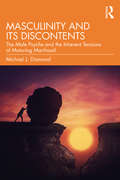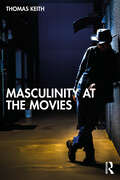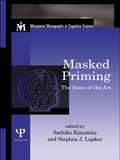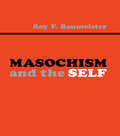- Table View
- List View
Marxism and the Individual
by Cem EroğulThis book attempts to develop a Marxist theory of the human individual. It contends that the standard description of the human as a bio-psycho-social being is fundamentally deficient as it doesn’t specify which of these attributes is the determining one. As long as this is not done, the real nature of humanity cannot be uncovered.
Marxism, Psychology and Social Science Analysis: Taking Sève Seriously
by Julian RocheMarxism, Psychology and Social Science Analysis applies Marxist theory, psychology, and the work of Lucien Sève to specific research in the social sciences. It shows in practical terms what guidance can be offered for social scientific researchers wanting to incorporate Sève’s view of personality into their work. Providing case studies drawn from different social sciences that give the book significant breadth of scope, Roche reviews the impact of "Taking Sève Seriously" across the study of international relations theory, economics, law, and moral philosophy. The book begins by placing the work of Lucien Sève in context and considers the development of psychology in relation to Marxism, before going on to summarise the work of Sève in relation to the psychology of personality. It considers the opportunities for refreshed research in social relations based on developments by Sève, before examining Marxist biography and the implications of Sève’s views. The book also includes chapters on the social discount rate, on constructivism in international relations, on the concept of promising in moral philosophy and the Marxist conception of individual responsibility. It addresses not only how research should be carried out differently, but whether utilising the theoretical framework of other writers, even non-Marxists, can deliver a similar outcome. With its use of five distinct case studies to analyse the work of Lucien Sève, this unique book will be of great interest to academics, researchers and postgraduate students in the fields of psychology, philosophy and social sciences.
Marx’s General: The Revolutionary Life of Friedrich Engels
by Tristram HuntFriedrich Engels is one of the most intriguing and contradictory figures of the nineteenth century. Born to a prosperous mercantile family, he spent his life enjoying the comfortable existence of a Victorian gentleman; yet he was at the same time the co-author of The Communist Manifesto, a ruthless political tactician, and the man who sacrificed his best years so that Karl Marx could have the freedom to write. Although his contributions are frequently overlooked, Engels's grasp of global capital provided an indispensable foundation for communist doctrine, and his account of the Industrial Revolution, The Condition of the Working Class in England, remains one of the most haunting and brutal indictments of capitalism's human cost. <p><p>Drawing on a wealth of letters and archives, acclaimed historian Tristram Hunt plumbs Engels's intellectual legacy and shows us how one of the great bon viveurs of Victorian Britain reconciled his exuberant personal life with his radical political philosophy. This epic story of devoted friendship, class compromise, ideological struggle, and family betrayal at last brings Engels out from the shadow of his famous friend and collaborator.
Mary D. Sheridan's Play in Early Childhood: From Birth to Six Years
by Justine HowardMary D. Sheridan’s Play in Early Childhood is a classic introductory text to play and development – key topics for all those who work with young children. Drawing on the most up-to-date evidence, it explains how children’s play develops and how they develop as they play. With over 100 illustrations and observations of play from birth to six years, this new edition presents classical and contemporary literature, making clear links between play and all areas of children’s development. It includes updated activities to consolidate thinking and suggestions for further reading throughout. This text considers: the development, value and characteristics of play issues relating to culture, adversity, gender, attachment and brain development play from recreational, therapeutic and educational perspectives the role of parents/caregivers and professionals in supporting play how to develop observation and reflection skills for use in your own practice Suitable both for those new to the area and for more experienced workers wanting a quick reference guide, this easy-to-follow book meets the needs of students and professionals from a wide range of health, education and social care backgrounds, including early years professionals, playworkers, children’s nurses, play therapists and social workers.
Mary Douglas (Anthropology's Ancestors #4)
by Perri 6 Paul RichardsThis handy, concise book covers the life of Mary Douglas, one of the most important anthropologists of the second half of the 20th century. Her work focused on how human groups classify one another, and how they resolve the anomalies that then arise. Classification, she argued, emerges from practices of social life, and is a factor in all deep and intractable human disputes. This biography offers an introduction to how her distinctive approach developed across a long and productive career and how it applies to current pressing issues of social conflict and planetary survival. From the Preface: The influence of Professor Dame Mary Douglas (1921-2007) upon each of the social sciences and many of the disciplines in the humanities is vast. The list of her works is also vast, and this presents a problem of choice for the many readers who want to get a general idea of what she wrote and its significance, but who are somewhat baffled about where to begin. Our book offers a short overview and suggests why her key writings remain significant today.
Mary P. Follett: Creating Democracy, Transforming Management
by Joan C. TonnMary P. Follett (1868-1933) brought new dimensions to the theory and practice of management and was one of America's preeminent thinkers about democracy and social organization. The ideas Follett developed in the early twentieth century continue even today to challenge thinking about business and civic concerns. This book, the first biography of Follett, illuminates the life of this intriguing woman and reveals how she devised her farsighted theories about the organization of human relations. --BOOK JACKET. Title Summary field provided by Blackwell North America, Inc. All Rights Reserved
Mary Page Marlowe (TCG Edition)
by Tracy LettsBest known for his portrayals of large-scale family drama, Tracy Letts’ new play narrows in focus, zooming in on the life of just one woman, though her story is no less complex. This intimate snapshot of a simple life provides an enlightening examination of a complicated human mind.
Maschinenliebe: Liebespuppen und Sexroboter aus technischer, psychologischer und philosophischer Perspektive
by Oliver BendelSexroboter sind ein Thema, das die Medien mit Vorliebe behandeln und die Gesellschaft spaltet. Es gibt einige Modelle wie Emma oder Harmony. Viel verbreiteter sind allerdings einfache Liebespuppen mit überzeugender Haut und auswechselbaren Körperöffnungen. Sie finden sich in zahlreichen Bordellen und können problemlos bei Amazon und Co. bestellt werden. Zwischen Liebespuppen und Sexrobotern sind die Grenzen fließend. Sobald Liebespuppen sprechen können oder Sensoren und Aktoren haben, werden sie zu Sexrobotern. Einzelne Varianten weisen mimische Fähigkeiten auf und können den Kopf bewegen. Das Buch erklärt Grundbegriffe, geht auf technische Details ein und diskutiert psychologische, soziologische und philosophische Erkenntnisse und Herausforderungen. Es beleuchtet die Praxis der Sexarbeit und liefert Stellungnahmen von Herstellern und Benutzern.
Masculine Power and Gender Equality: Masculinities As Change Agents
by Russell Luyt Kathleen StarckThis book explores how political institutions can challenge dominant and normative masculinities, guiding thinking instead toward a transformation of gendered power structures and general equality. Representing a range of relevant areas, the expert chapter authors provide various methodological and theoretical approaches applied to shifting gender meanings in cultural, national, and social contexts. Authors also represent a variety of cultures, contributing to the multi-perspective debate about how best to achieve gender equality in the real world.Among the topics discussed:Reimagining masculinities, their everyday practice and practical interventions Towards a feminist theory of male rapePolitical implications of challenging men’s everyday practices through domestic violence primary prevention workMen as allies: a case study of White Ribbon AustraliaMasculine Power and Gender Equality: Masculinities as Change Agents provides valuable insight into strategies for re-imagining male-dominated power structures and promoting gender equality.
Masculine Scenarios (Psychoanalysis and Women Series)
by Mariam Alizade'Human identity, sexual identity, primary and secondary identification, object choice, narcissism - all of these lie on a continuum with homosexuality, transsexualism, transvestism, heterosexuality and asexuality. Concepts on sexuality and gender are outlined anew in an interplay of theoretical and clinical networks, with the aim of increasing the efficiency of analytic praxis freed from prejudice and monolithic convention.'- the author, from the Foreword Masculine Scenarios is the third volume in a unique series edited by the author for the Committee on Women and Psychoanalysis of the International Psychoanalytical Association. Providing a forum for exploration and discussion of diverse issues relating to gender constructs, sexuality, and sexual identity, the series brings together an internationally renowned group of contributors trained in the psychoanalytic tradition. Masculine Scenarios concentrates on issues regarding the psychic world of men and male sexuality. The construction of gender identity, the battle of the sexes, transsexualism, homosexuality and masculinity are some of the topics discussed in this inspiring book.
Masculine Shame: From Succubus to the Eternal Feminine (Routledge Studies In Religion Ser.)
by Mary Y. AyersHow does the image of the succubus relate to psychoanalytic thought? Masculine Shame: From Succubus to the Eternal Feminine explores the idea that the image of the succubus, a demonic female creature said to emasculate men and murder mothers and infants, has been created out of the masculine projection of shame and looks at how the transformation of this image can be traced through Western history, mythology, and Judeo-Christian literature. Divided into three parts areas of discussion include: the birth of civilization and the evolution of the succubus the image of the succubus in the writings of Freud and Jung the succubus as child killing mother to the restoration of the eternal feminine. Through a process of detailed cultural and social analysis, the author places the image of the succubus at the very heart of psychoanalytic thought, highlighting its presence in both Freud’s Medusa and Jung’s visions of Salome. As such, this book will be of great interest to all those in the fields of analytical psychotherapy and psychoanalysis.
Masculine and Feminine: The Natural Flow of Opposites in the Psyche
by Gareth S. HillA Jungian analyst provides a new model for understanding the masculine and feminine principles that exist in everyone, providing insight into the events of daily life and the themes of entire lifetimes.
Masculinidades
by Pedro UribeUn lúcido ensayo sobre las masculinidades, el rol de los hombres en la sociedad compleja de hoy y las distintas visiones que existen sobre la virilidad, el patriarcado y la deconstrucción de lo masculino. En tiempos en que el feminismo parece tomarse el debate, el sicólogo Pedro Uribe escribe sobre las luces y las sombras que están atravesando las relaciones entre los hombres y las mujeres en una sociedad compleja y turbulenta como la actual. Y se pregunta: ¿qué está pasando con los hombres?, ¿por qué algunos son violentos y otros, criados del mismo modo, no ejercen violencia de género?, ¿por qué los hombres actúan así? ¿qué están sintiendo? Desvelando el manto de misterio que cubre la masculinidad, esta es una invitación a pensar y ampliar las miradas sobre el rol de los varones en la sociedad de hoy.
Masculinities and Mental Health in Young Men: From Echo Chambers to Evidence
by Zac SeidlerThis book seeks to understand young men’s mental health by going to the places and spaces where they spend their time. It is essential reading for researchers, clinicians, policymakers and members of the general public who care about men’s wellbeing. Each chapter focuses on the contemporary nexus between masculinities and health, encompassing alcohol, gambling, sport, gaming, social media, pornography, and dating apps, to explore how and why these areas are central to young men’s lives and their health. Addressing the present day ‘crisis of masculinity’, this edited volume comprises a series of up-to-date reviews to emphasise strength-based, healthy masculinities in young men’s mental health. It seeks to understand and engage with research, policy, and practice to co-design effective interventions supporting young men, presenting a clear agenda to direct future efforts.
Masculinities in Transition
by Victoria Robinson Jenny HockeyContributing to feminist approaches to masculinities, this book examines men's contextual experiences of masculine identity. Drawing on new data which compares men as they move across and between public and domestic spaces, it explores the implications of this for the nature of contemporary masculinity.
Masculinities in a Global Era
by Joseph GelferMasculinities in a Global Era extends the conversation of masculinity studies by analyzing global masculinities from a psychological perspective. Canvassing a broad array of psychological aspects such as the construction of identity, the negotiation of power, coping with trauma, and sexuality, this volume shows how masculinities are experienced, performed and embodied in geographically dispersed communities. Importantly, Masculinities in a Global Era fulfills a much-needed but elusive need within the study of masculinities: a forum in which the often polarized approaches of pro-feminists and men's rights advocates can begin to move beyond their entrenched historical positions towards a more fruitful and nuanced future.
Masculinity Meets Humanity: An Adapted Model of Masculinised Psychotherapy (Routledge/UNISA Press Series)
by Shahieda JansenIn this book the author, a clinical psychologist, reflects on her psychotherapy experiences with male clients as she debunks the myth of male alexithymia, the inability to recognise and express emotions. Men are apparently disengaged from wellness practices as they are perceived to be reluctant to seek mental health care. An ubuntu-inspired personhood discourse of trust, empathy and transformation theoretically underpins the author’s clinical practice. The integration of the culturally familiar philosophy of ubuntu challenges the hegemony of strictly modern Western psychological discourses and theories. Although the book is not a manual for how to do therapy with men, neither a panacea for all male related challenges, it can ignite empathic insights and kindle gender sensitive responses to male concerns, locally and internationally. Women, who are frequently the targets of gender-based violence primarily committed by men, may play a significant role in the rehabilitation and healing of men. Men are usually excluded from psychosocial interventions, but this book makes the case that prioritsing the wellbeing of boys and men is critical to creating a society that is safe for everyone—men, women, children, and the broader public. Print editions not for sale in Sub-Saharan Africa.
Masculinity and Femininity Today (Psychoanalysis and Women Series)
by Frances Thomson-Salo Ester Palerm MaríThis book presents a wide range of psychoanalytic writing on masculinity and femininity from British, European, and North and South American perspectives, exploring how masculine and feminine aspects are structured and evolve in the child, adolescent and adult. The authors address from a background of considerable clinical experience how masculinity and femininity manifest in the body, gender, sex, sexuality and the life-cycle, and cover aspects both productive and generative, constricted and defended. The importance of the parenting couple and their bond with the child in the forming of masculine and feminine idenitities is emphasized. Beginning with an overview of the development of masculinity, the developmental perspective is explored in how adolescents discover their sexuality and come to 'own' their sexual bodies. Different types of disturbance are explored including the early defence mechanism of disavowal of difference.
Masculinity and Femininity: The Taboo Dimension of National Cultures (Cross Cultural Psychology)
by Geert HofstedeIn 1980, Geert Hofstede published his monumental work CultureÆs Consequences, which laid out four dimensions on which the differences among national cultures could be understood: individualism, power distance, uncertainty avoidance, and masculinity. Since then much research has been conducted and presented on individualism/collectivism but until now, no single volume has focused on the masculinity dimension of the model. In Masculinity and Femininity, Hofstede has expanded, sharpened, and deepened the discussion of masculinity and femininity. This new volume presents the first thoroughly developed discussion of this dimension and how it can help us understand the differences among cultures. It begins with a general explanation of masculinity and discusses how it illuminates broad features of different cultures. It then applies the dimension more specifically to gender, sexuality, and religion. Finally, the book examines how the masculinity dimension reveals a lot about a cultureÆs expressions of religious ideas, the importance its citizens attach to religion, and the way religious concepts are understood. Intended as a companion volume to KimÆs Individualism and Collectivism, this important volume will be of interest to those teaching courses such as cross-cultural psychology, international social welfare, international business, womenÆs studies, cultural studies, and the psychology of women.
Masculinity and Its Discontents: The Male Psyche and the Inherent Tensions of Maturing Manhood
by Michael J. DiamondOffering a uniquely psychoanalytic developmental perspective on male gender identity and the sense of maleness, this book provides an in-depth analysis of the development of masculinity in childhood and its continued evolution throughout a man’s life. Drawing on classical Freudian theory, as well as on more contemporary psychoanalytic theories, this book explores early infancy and child development, preoedipal factors and the oedipal complex, the influence of parenting and the unconscious transmission of gendered factors both by mothers and both biological and symbolic fathers, the male ego ideal, social, cultural, and biological influences, the role of inherent psychic bi-genderality in the context of gender binaries, and the inherent gendered tensions and challenges experienced as an individual progresses into adult and later life. This book is original in its characterization of the male developmental trajectory as underpinned by psychoanalytic principles pertaining to conflict and inherent tensions that continue throughout the life cycle and strongly impact other areas of life. Deeply rooted in the unconscious, a man’s multiply determined sense of masculinity requires deconstructing the mother, the feminine, and the other in the male psyche. As the text illustrates via clinical vignettes, an awareness and an understanding of these areas can improve the clinical work of psychoanalysts working with men who struggle with the intrinsic conflicts in their sense of maleness. This book will be of great clinical value to psychoanalysts, psychotherapists and other mental health practitioners, and will stimulate the thinking of scholars in such areas as gender theory, psychodynamic and sociocultural aspects of gender roles, and the changing social definition of masculinity.
Masculinity at the Movies
by Thomas KeithMasculinity at the Movies takes a deep dive into masculinity in film and how Hollywood movies continue to produce and promote masculine stereotypes that place boys and men in constraining identities and dysfunctional patterns of behaviour.From classic film stars to those of the present day, this textbook unpacks the development of the main male stereotypes in film – villains, heroes, and oafs – and how movies can develop healthy new male representations. Alongside Hollywood studio productions, it delves into Black, Native American, Latino, and Asian representation as well as LGBTQ masculinity. Going beyond the present, it proposes what healthy masculinity at the movies looks like and where Hollywood should set its sights to create more progressive models of masculinity for the 21st century.Masculinity at the Movies will provide students of gender studies, media studies, and cultural studies with new insights into stereotypes of men in contemporary film.
Masked Priming: The State of the Art (Macquarie Monographs in Cognitive Science)
by Sachiko Kinoshita Stephen J. LupkerMasked priming has a short and somewhat controversial history. When used as a tool to study whether semantic processing can occur in the absence of conscious awareness, considerable debate followed, mainly about whether masked priming truly tapped unconscious processes. For research into other components of visual word processing, however - in particular, orthographic, phonological, and morphological - a general consensus about the evidence provided by masked priming results has emerged. This book contains thirteen original chapters in which these three components of visual word processing are examined using the masked priming procedure. The chapters showcase the advantages of masked priming as an alternative to more standard methods of studying language processing that require comparisons of matched items. Based on a recent conference, this book offers up-to-date research findings, and would be valuable to researchers and students of word recognition, psycholinguistics, or reading.
Masks and Human Connections: Disruptive Meanings and Cultural Challenges
by Luísa Magalhães Cândido Oliveira MartinsThis interdisciplinary collection explores four distinct perspectives about the mask, as object of use for protection, identity, and disguise. In part I, contributors address human identities within collective social performance, with chapters on performativity and the far right and masked identities in political resistance and communication. Part II focuses on the mask as a signifying object with strong representational challenges, exploring representations in festivals, literature, and film. Part III investigates the ambiguous use of the mask as a protective and concealing element, delving into visual culture and digital social media contexts. Finally, Part VI draws on the work of Levinas and Deleuze to investigate a philosophical view of the mask that addresses memory and ethics within intersubjective relationships. Questioning the contemporary world, using communication, sociology, visual culture, and philosophical theory, the volume provides a pedagogical and formative perspective on the mask.
Masochism and the Self
by Roy F. BaumeisterThis volume provides an integrative theory firmly grounded in current psychology of the self, and offers a fresh, compelling account of one of psychology's most enigmatic behavior patterns. Professor Baumeister provides comprehensive coverage of historical and cross-cultural theories and empirical data on masochism and presents recent, original data drawn from a large data set of anonymous masochistic scripts of fantasies and favorite experiences. Drawn from the latest social psychological research and theories, Professor Baumeister returns the emphasis to the original and proto-typical form of masochism -- sexual masochism - - and explains these phenomena as a means of releasing the individual from the burden of self-awareness. It is the first volume to present a psychological theory compatible with the mounting evidence that most masochists are not mentally ill nor does masochism derives from sadism. Instead, Professor Baumeister finds that masochism emerges as an escapist response to the problematic nature of selfhood and he attempts to foster an understanding of sexual masochism that emphasizes both "escape from self" and "construction of meaning" hypotheses. The book is directed at all those interested in the self and identity in paradoxical behavior patterns and in the construction of meaning, presenting specific clinical recommendations.
Masochism and the Self
by Roy F. BaumeisterThis volume provides an integrative theory firmly grounded in current psychology of the self, and offers a fresh, compelling account of one of psychology's most enigmatic behavior patterns. Professor Baumeister provides comprehensive coverage of historical and cross-cultural theories and empirical data on masochism and presents recent, original data drawn from a large data set of anonymous masochistic scripts of fantasies and favorite experiences. Drawn from the latest social psychological research and theories, Professor Baumeister returns the emphasis to the original and proto-typical form of masochism -- sexual masochism - - and explains these phenomena as a means of releasing the individual from the burden of self-awareness. It is the first volume to present a psychological theory compatible with the mounting evidence that most masochists are not mentally ill nor does masochism derives from sadism. Instead, Professor Baumeister finds that masochism emerges as an escapist response to the problematic nature of selfhood and he attempts to foster an understanding of sexual masochism that emphasizes both "escape from self" and "construction of meaning" hypotheses. The book is directed at all those interested in the self and identity in paradoxical behavior patterns and in the construction of meaning, presenting specific clinical recommendations.

